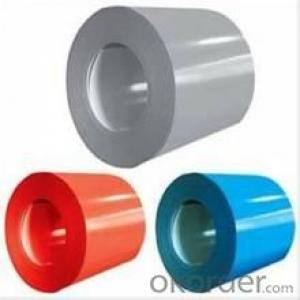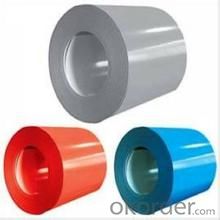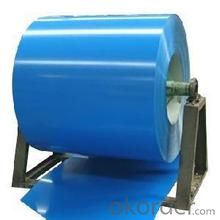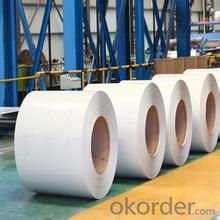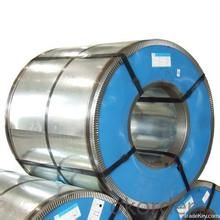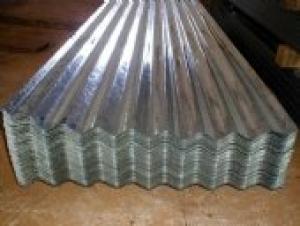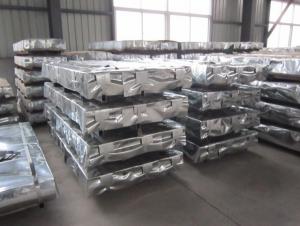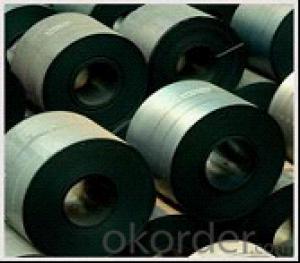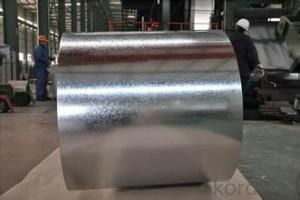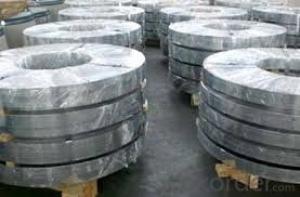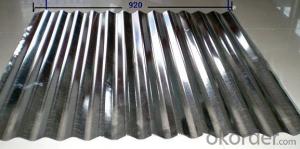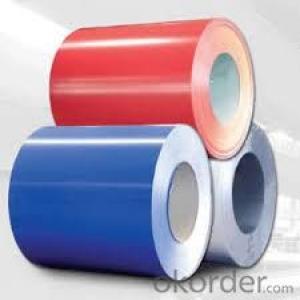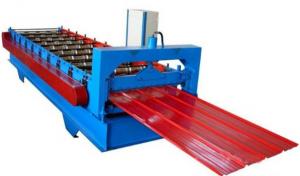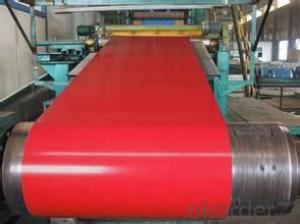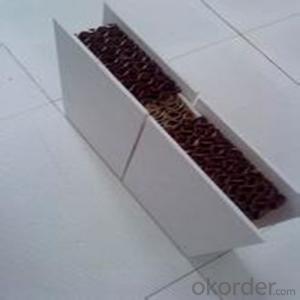Prepainted galvanized corrugated plate / sheet CSB
- Loading Port:
- Tianjin
- Payment Terms:
- TT OR LC
- Min Order Qty:
- 30 m.t.
- Supply Capability:
- 500000 m.t./month
OKorder Service Pledge
OKorder Financial Service
You Might Also Like
Specification:
1.material :
galvanized steel sheet / prepainted galvanized sheet
2.sheet thickness :
normal use 0.3-0.6mm
3.length:
any length,according to the transportation,generally less than 12m
4.color
standard color:red,blue,white,grey
special color:according to RAL color
Description:
prepainted corrugated steel plate | |
material | galvanized steel sheet |
prepainted galvanized sheet | |
model No. | types of roof sheets |
sheet thickness | normal use 0.3-0.6mm |
length | any length,according to the transportation,generally less than 12m |
color | standard color:red,blue,white,grey |
special color:according to RAL color | |
characteristic | 1:weather proof |
2:heating insulation | |
3:fireproof | |
4:anti-rust | |
5:sound insulation | |
6:long life span:more than 15 years | |
advantages | 1.low foundation cost |
2.easy construction | |
3.time saving | |
4.labor saving | |
application field | 1:construction:prefabricated house,steel house,mobile house,modular house,villa,bungalow design,portable house/carbin,ready made house,kiosk booths,steel building... |
2:container manufacturing | |
3:household appliances and furniture | |
4:vehicle and vessel manufacturing | |
5:others,like machinery structual parts,maufacturing shells of motors and so on | |
packing | plastic film,pallet or as your request |
Images:
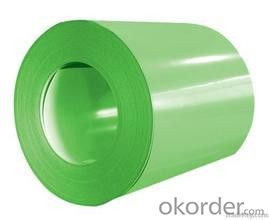
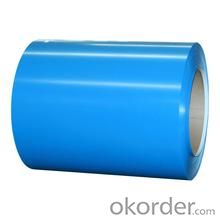
- Q: Can the steel sheets be used for outdoor furniture?
- Yes, steel sheets can be used for outdoor furniture. Steel is a durable and weather-resistant material, making it suitable for outdoor applications. It can withstand various environmental conditions such as rain, wind, and sunlight without corroding or deteriorating quickly. Additionally, steel sheets can be molded and shaped into different furniture designs, providing both functionality and aesthetic appeal. Whether it's for tables, chairs, benches, or even decorative elements, steel sheets can be an excellent choice for outdoor furniture due to their strength, longevity, and versatility.
- Q: How do you cut a steel sheet?
- To cut a steel sheet, you typically use power tools such as a plasma cutter, laser cutter, or angle grinder equipped with a cutting disc designed for metal. These tools are capable of generating high heat and precision to make clean cuts through the tough steel material. Safety precautions, like wearing protective gear and ensuring a stable work surface, are crucial when working with power tools and cutting steel sheets.
- Q: What are the different surface finishes for galvalume steel sheets?
- Some of the different surface finishes for galvalume steel sheets include regular spangle, minimized spangle, and zero spangle.
- Q: What is the maximum load-bearing capacity of steel sheets?
- The maximum load-bearing capacity of steel sheets can vary depending on the specific type and thickness of the steel sheet. Generally, steel sheets are known for their high strength and durability, allowing them to support heavy loads. The load-bearing capacity of steel sheets is typically measured in terms of its yield strength or ultimate tensile strength. Yield strength refers to the maximum amount of stress that a steel sheet can withstand before it begins to deform permanently, while ultimate tensile strength refers to the maximum stress it can handle before fracturing. The load-bearing capacity of steel sheets can range from a few hundred pounds to several thousand pounds per square inch (psi). For example, mild steel sheets typically have a yield strength of around 50,000 psi, allowing them to support moderate loads. High-strength steel sheets, on the other hand, can have a yield strength of over 100,000 psi, enabling them to withstand heavy loads. It's important to note that the load-bearing capacity of steel sheets can also be influenced by factors such as the sheet's dimensions, surface condition, and the method of support. Additionally, engineers and structural designers often consider safety margins and factor of safety when determining the maximum load-bearing capacity of steel sheets in specific applications. Therefore, it is recommended to consult relevant engineering standards, specifications, or professionals for accurate load-bearing capacity information in a particular context.
- Q: How are steel sheets packaged for shipping?
- Steel sheets are typically packaged for shipping in a way that ensures their protection during transportation. The packaging process involves various steps to prevent any damage or deformation that may occur during transit. Firstly, the steel sheets are usually stacked on wooden pallets or placed in sturdy steel crates. This helps to provide a stable base and prevents any movement or shifting of the sheets during transportation. The use of pallets or crates also makes it easier to load and unload the sheets onto trucks or containers. To further protect the steel sheets from scratches or other forms of surface damage, they are often covered with a layer of protective material. This can include plastic wraps, paper or cardboard interleaves, or even a layer of oil or rust inhibitor. These protective materials act as a barrier between the steel sheets, preventing any direct contact that may cause scratches. Additionally, steel sheets may be bundled together with steel strapping or wire to keep them securely in place. This bundling process helps to maintain the structural integrity of the sheets and prevents them from shifting or sliding during transportation. Finally, once the steel sheets are properly packaged, they are typically labeled with relevant information such as product specifications, quantity, and destination. This ensures that the sheets can be easily identified and handled correctly at each stage of the shipping process. Overall, the packaging of steel sheets for shipping is carefully done to ensure their safe and secure transportation. By using pallets or crates, protective materials, bundling, and labeling, steel sheets can withstand the rigors of shipping and arrive at their destination in optimal condition.
- Q: How are steel sheets protected during storage in warehouse facilities?
- Steel sheets are protected during storage in warehouse facilities through various methods to ensure their integrity and prevent damage. One common method is the use of protective coatings or finishes. Prior to storage, steel sheets are often coated with a layer of oil or wax to provide a barrier against moisture and rust. This coating acts as a protective shield, preventing oxidation and corrosion. In addition to coatings, steel sheets are usually stacked and stored in a way that minimizes the risk of physical damage. They are typically placed on pallets or racks, with proper spacing and support to prevent bending or warping. This ensures that the weight is evenly distributed and reduces the risk of deformation. Moreover, warehouse facilities employ various measures to control the environment and protect steel sheets from adverse conditions. For instance, temperature and humidity levels are closely monitored and regulated to prevent moisture buildup, as excessive humidity can accelerate corrosion. Adequate ventilation systems are installed to maintain a dry environment and prevent condensation. Furthermore, warehouse facilities often implement strict security measures to safeguard steel sheets from theft or unauthorized access. These measures may include surveillance cameras, access control systems, and security personnel to prevent any potential damage or loss. Overall, by using protective coatings, proper stacking techniques, controlling the environment, and implementing security measures, warehouse facilities ensure that steel sheets are well-protected during storage, preserving their quality and preventing any potential damage.
- Q: What is the minimum order quantity for steel sheets?
- The minimum order quantity for steel sheets can vary depending on the supplier and specific requirements. It is best to contact the supplier directly to inquire about their minimum order quantity for steel sheets.
- Q: Are steel sheets suitable for bridge construction?
- Yes, steel sheets are suitable for bridge construction. Steel sheets provide high strength, durability, and flexibility, allowing for the construction of long-span bridges. Additionally, steel sheets are resistant to corrosion, making them ideal for bridges exposed to harsh environmental conditions.
- Q: Can steel sheets be used for architectural designs?
- Yes, steel sheets can be used for architectural designs. Steel is a versatile and durable material that can be shaped into various forms and sizes, making it suitable for a wide range of architectural applications. It can be used for building facades, roofing, cladding, structural supports, and decorative elements. Additionally, steel sheets offer excellent strength-to-weight ratio, corrosion resistance, and fire resistance, making them a popular choice among architects and designers for both functional and aesthetic purposes.
- Q: Are steel sheets suitable for electrical transformer cores?
- Yes, steel sheets are suitable for electrical transformer cores. Steel is a commonly used material for transformer cores due to its magnetic properties and ability to efficiently conduct magnetic flux. The laminated steel sheets used in transformer cores are typically made from high-grade electrical steel, also known as silicon steel or transformer steel. This type of steel has low core losses and high magnetic permeability, making it an ideal choice for transformer applications. The laminated structure of the steel sheets helps reduce eddy current losses by creating a path of high electrical resistance. These sheets are coated with an insulating varnish to further minimize eddy current losses and prevent electrical short circuits. The laminations are then stacked together to form the core, providing a low reluctance path for the magnetic field generated by the transformer's primary winding. The use of steel sheets in transformer cores ensures efficient energy transfer by minimizing energy losses. The magnetic properties of steel contribute to the transformation and regulation of electrical power, allowing transformers to step up or step down voltage levels while maintaining high efficiency. Additionally, steel sheets offer excellent mechanical strength and stability, ensuring the long-term durability of transformer cores. In summary, steel sheets are highly suitable for electrical transformer cores due to their magnetic properties, low core losses, high magnetic permeability, and mechanical strength. These properties enable efficient energy transfer, voltage regulation, and long-term reliability in transformer applications.
Send your message to us
Prepainted galvanized corrugated plate / sheet CSB
- Loading Port:
- Tianjin
- Payment Terms:
- TT OR LC
- Min Order Qty:
- 30 m.t.
- Supply Capability:
- 500000 m.t./month
OKorder Service Pledge
OKorder Financial Service
Similar products
Hot products
Hot Searches
Related keywords
